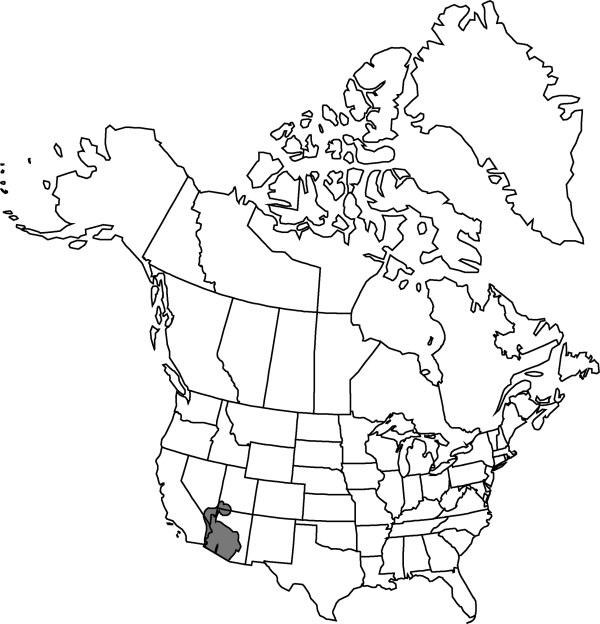Difference between revisions of "Cylindropuntia acanthocarpa"
in C. Backeberg and F. M. Knuth, Kaktus-ABC, 124. 1935.
FNA>Volume Importer |
RevisionBot (talk | contribs) m (Bot: Adding category Revised Since Print) |
||
| (4 intermediate revisions by 3 users not shown) | |||
| Line 1: | Line 1: | ||
{{Treatment/ID | {{Treatment/ID | ||
|accepted_name=Cylindropuntia acanthocarpa | |accepted_name=Cylindropuntia acanthocarpa | ||
| − | |accepted_authority=(Engelmann & J. M. Bigelow) | + | |accepted_authority=(Engelmann & J. M. Bigelow) F. M. Knuth |
|publications={{Treatment/Publication | |publications={{Treatment/Publication | ||
|title=in C. Backeberg and F. M. Knuth, Kaktus-ABC, | |title=in C. Backeberg and F. M. Knuth, Kaktus-ABC, | ||
| Line 8: | Line 8: | ||
}} | }} | ||
|common_names=Buckhorn cholla | |common_names=Buckhorn cholla | ||
| + | |special_status={{Treatment/ID/Special_status | ||
| + | |code=F | ||
| + | |label=Illustrated | ||
| + | }} | ||
|basionyms={{Treatment/ID/Basionym | |basionyms={{Treatment/ID/Basionym | ||
|name=Opuntia acanthocarpa | |name=Opuntia acanthocarpa | ||
| Line 26: | Line 30: | ||
-->{{Treatment/Body | -->{{Treatment/Body | ||
| − | |distribution= | + | |distribution=Ariz.;Calif.;Nev.;Utah;n Mexico. |
|discussion=<p>Varieties 4 (4 in the flora).</p><!-- | |discussion=<p>Varieties 4 (4 in the flora).</p><!-- | ||
--><p><i>Cylindropuntia acanthocarpa</i> hybridizes with <i>C. abyssi</i>, <i>C. echinocarpa</i> (= C. ×deserta), <i>C. bigelovii</i> (= C. ×campii), <i>C. leptocaulis</i> (see <i>C. ×tetracantha</i>), C. ×multigeniculata, <i>C. spinosior</i>, <i>C. versicolor</i>, and <i>C. whipplei</i> (= C. congesta). Hybrids of <i>C. acanthocarpa</i> and C. ×multigeniculata are more open in habit, with longer stem segments than C. ×multigeniculata and with reddish filaments like <i>C. acanthocarpa</i>.</p> | --><p><i>Cylindropuntia acanthocarpa</i> hybridizes with <i>C. abyssi</i>, <i>C. echinocarpa</i> (= C. ×deserta), <i>C. bigelovii</i> (= C. ×campii), <i>C. leptocaulis</i> (see <i>C. ×tetracantha</i>), C. ×multigeniculata, <i>C. spinosior</i>, <i>C. versicolor</i>, and <i>C. whipplei</i> (= C. congesta). Hybrids of <i>C. acanthocarpa</i> and C. ×multigeniculata are more open in habit, with longer stem segments than C. ×multigeniculata and with reddish filaments like <i>C. acanthocarpa</i>.</p> | ||
| Line 67: | Line 71: | ||
-->{{#Taxon: | -->{{#Taxon: | ||
name=Cylindropuntia acanthocarpa | name=Cylindropuntia acanthocarpa | ||
| − | |authority=(Engelmann & J. M. Bigelow) | + | |authority=(Engelmann & J. M. Bigelow) F. M. Knuth |
|rank=species | |rank=species | ||
|parent rank=genus | |parent rank=genus | ||
| Line 73: | Line 77: | ||
|basionyms=Opuntia acanthocarpa | |basionyms=Opuntia acanthocarpa | ||
|family=Cactaceae | |family=Cactaceae | ||
| − | |distribution= | + | |distribution=Ariz.;Calif.;Nev.;Utah;n Mexico. |
|reference=None | |reference=None | ||
|publication title=in C. Backeberg and F. M. Knuth, Kaktus-ABC, | |publication title=in C. Backeberg and F. M. Knuth, Kaktus-ABC, | ||
|publication year=1935 | |publication year=1935 | ||
| − | |special status= | + | |special status=Illustrated |
| − | |source xml=https:// | + | |source xml=https://bitbucket.org/aafc-mbb/fna-data-curation/src/2e0870ddd59836b60bcf96646a41e87ea5a5943a/coarse_grained_fna_xml/V4/V4_222.xml |
|subfamily=Cactaceae subfam. Opuntioideae | |subfamily=Cactaceae subfam. Opuntioideae | ||
|genus=Cylindropuntia | |genus=Cylindropuntia | ||
| Line 84: | Line 88: | ||
}}<!-- | }}<!-- | ||
| − | -->[[Category:Treatment]][[Category:Cylindropuntia]] | + | --> |
| + | |||
| + | [[Category:Treatment]] | ||
| + | [[Category:Cylindropuntia]] | ||
| + | [[Category:Revised Since Print]] | ||
Latest revision as of 18:01, 6 November 2020
Trees or shrubs, sparsely to densely branched, 1–2(–4) m. Stem segments firmly attached, cylindric, 10–30(–50) × 2–2.5(–3) cm; tubercles prominent, narrow to broad, 1.5–4.5 cm; areoles elliptic to subcircular, 4–5.5 × 4–5 mm; wool white or yellowish to tan, aging gray-black. Spines 6–20(–30+) per areole, often accompanied by 0–5 short bristlelike spines at areole margins, usually in distal areoles; major abaxial spines deflexed to divergent, subterete to flattened; major adaxial spines ascending-divergent, terete, yellow or tan to deep red-brown, aging gray, the central spine longest, 12–30(–38) mm; sheaths white to grayish with yellow to golden tips, baggy to tight fitting. Glochids in inconspicuous to small adaxial tuft, yellow to brown, 0.5–2 mm. Flowers: inner tepals bright yellow to bronze to brick red, spatulate, 20–30 mm, apiculate-emarginate; filaments red; anthers yellow; style and stigma lobes white to light green. Fruits tan at maturity, obconic to ellipsoid, 15–35 × 15–20 mm, dry, tuberculate, densely to sparsely spiny (rarely spineless), with apical flange above shallow umbilicus; basal tubercles longest; areoles 12–30. Seeds pale yellow to tan, angular or squarish in outline, warped, 3.5–5 × 3–4.5 mm, sides smooth, each with 2–4 large depressions; girdle smooth.
Distribution

Ariz., Calif., Nev., Utah, n Mexico.
Discussion
Varieties 4 (4 in the flora).
Cylindropuntia acanthocarpa hybridizes with C. abyssi, C. echinocarpa (= C. ×deserta), C. bigelovii (= C. ×campii), C. leptocaulis (see C. ×tetracantha), C. ×multigeniculata, C. spinosior, C. versicolor, and C. whipplei (= C. congesta). Hybrids of C. acanthocarpa and C. ×multigeniculata are more open in habit, with longer stem segments than C. ×multigeniculata and with reddish filaments like C. acanthocarpa.
Selected References
None.
Lower Taxa
Key
| 1 | Tubercles 2.5-4.5 cm, broad; stem segments gray-green; spines of adjacent areoles not or barely interlaced, 6-11(-14) per areole; fruits bearing few spines or sometimes spineless | Cylindropuntia acanthocarpa var. thornbe |
| 1 | Tubercles (1-)1.5-2.5(-3) cm, broad to narrow; stem segments green to yellow-green; spines of adjacent areoles interlaced; fruits densely spiny, sometimes burlike | > 2 |
| 2 | Abaxial 5-7 spines deflexed, usually subparallel, whitish to light brown; tubercles broad, oval; shrubs with few, ascending branches | Cylindropuntia acanthocarpa var. acantho |
| 2 | Abaxial (14-)18-30+ spines deflexed to divergent, spreading, pale yellow to red-brown; tubercles narrowly elliptic; shrubs with few to many, spreading branches | > 3 |
| 3 | Branches usually at acute angles; stem segments yellowish green, usually long, commonly 15-30 cm; spines 18-30+, yellow to tan, sheaths baggy; inner tepals yellow | Cylindropuntia acanthocarpa var. colorad |
| 3 | Branches usually at obtuse angles; stem segments green to dark green, usually short, commonly 8 -20 cm; spines 14-18(-23) per areole, yellow or red-brown, sheaths tight; inner tepals yellow to bronze to brick red | Cylindropuntia acanthocarpa var. major |